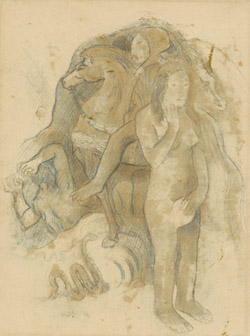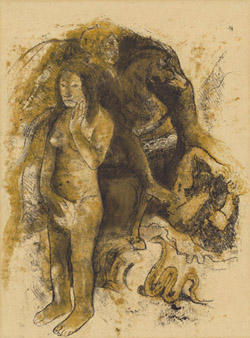The Technique
In 1900, during his final stay in Tahiti, Gauguin shipped this and nine other drawings to Paris. Made in a revolutionary technique (Gauguin called them "transfer drawings"), they meld powerful textural and rustic effects that demanded extraordinary control and calculation.
Gauguin first placed the piece of paper on top of another, inked sheet. He then drew the composition in black chalk and blue crayon, causing the ink from the bottom sheet to print on the other side of the top sheet. The other side of the paper then became the front of the drawing, or "recto" (see image at bottom).
Gauguin then printed more black, tacky printers' ink, as well as ocher ink, on the recto and made dark shadows by dissolving some of the ink with a solvent. The layers seem to peel away, giving the effect of a primitive, timeworn surface. |
 |

 Eve ("The Nightmare")
Eve ("The Nightmare") (verso), Paul Gauguin, about 1899–1900 |
The Subject
The subject of this drawing is a summation of the complex and personal imagery that Gauguin developed in Tahiti.
The female figure, covering her genitalia with a cloth and wearing a facial expression of doom and shame, is arguably the most dark and baleful of the many versions of Eve that populate Gauguin's Tahitian imagery. The hooded rider, who moves inexorably forward, suggests Death, while the profile recalls Gauguin's own face. The snake is a reference to the Fall of Man as described in the biblical book of Genesis. Thus, Gauguin wove elements of core traditional themes in Western art together with his own highly charged and personal references to sexuality, guilt, and evil. |
 |

 Eve ("The Nightmare")
Eve ("The Nightmare") (recto), Paul Gauguin, about 1899–1900 |